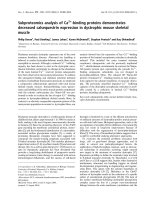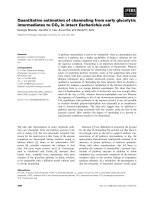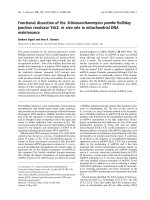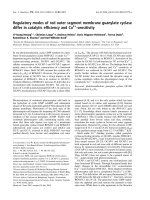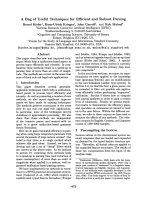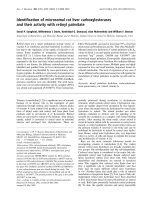Báo cáo khoa học: "Morphological variability of oak stands (Quercus petraea and Quercus robur) in northern Germany" docx
Bạn đang xem bản rút gọn của tài liệu. Xem và tải ngay bản đầy đủ của tài liệu tại đây (299.03 KB, 5 trang )
Original
article
Morphological
variability
of
oak
stands
(Quercus
petraea
and
Quercus
robur)
in
northern
Germany
G
Elsner
Niedersächsische
Forstliche
Versuchsanstalt,
Abt
C,
Abteilung
Forstpflanzenzüchtung,
3513
Staufenberg
OT
Escherode,
Germany
Summary —
According
to
the
German
law
concerning
forest
reproductive
material,
purity
of
species
is
required
for
the
admission
of
Quercus
robur
and
Q
petraea
as
seed
crop
stands.
A
method
for
species
identification
was
devised
by
the
Lower
Saxony
Research
Institute.
It
is
based
on
leaf
mor-
phology
and
calculates
a
discriminant
score
for
every
leaf
by
the
means
of
discriminant
analysis
in
comparison
with
2
pure
reference
stands.
In
this
way,
the
species
relationship
and
the
degree
of
ex-
pression
of
characters
are
assessed.
Leaf
samples
were
collected
in
733
oak
stands
in
Lower
Saxo-
ny
and
evaluated
for
every
stand.
Mixed
stands
and
stands
with
a
high
degree
of
intermediate
forms,
which
may
have
arisen
from
hybridization,
occur
besides
stands
of
pure
species.
Quercus
robur / Quercus petraea
I morphological
variability
/ discriminant
analysis
Résumé —
Variabilité
morphologique
des
peuplements
de
chêne
(Quercus
petraea
et
Quer-
cus
robur)
en
Allemagne
du
Nord.
La
loi
allemande
exige
un
contrôle
de
la
pureté
spécifique
des
chênaies
préalable
à
leur
classement
en
peuplements
porte-graines.
Dans
ce
but,
nous
avons
mis
au
point
une
méthode
de
reconnaissance
des
chênes
sessile
et
pédonculé
basée
sur
la
morpholo-
gie
foliaire.
Cent-cinquante
feuilles
sont
récoltées
au
sol
dans
chaque
peuplement.
Une
fonction
sta-
tistique
discriminante
a
été
établie
à
partir
de
2
peuplements
purs
de
référence.
L’étude
de
733
peu-
plements
de
Basse-Saxe
montre
la
présence
de
49%
de
peuplements
pédonculés,
40%
de
sessiles
et
11
%
d’hybrides.
Même
les
peuplements
dominés
par
une
seule
espèce
possèdent
souvent
des
feuilles
de
forme
intermédiaire.
La
part
respective
de
l’hybridation
et
de
la
variabilité
intra-arbre
dans
l’interprétation
de
ces
résultats
est
discutée.
Quercus
robur
/
Quercus
petraea
/ variabilité
morphologique
/ analyse
discriminante
INTRODUCTION
Quercus
petraea
(Mattuschka)
Liebl
and
Quercus
robur
L
are
native
to
Lower
Saxo-
ny.
Both
species
are
targeted
by
the
law
concerning
forest
reproductive
material
(Anonymous,
1979).
According
to
this
law,
only
stands
of
pure
species
can
be
classi-
fied
as
seed
crop
stands
or,
in
exceptional
cases,
stands
that
exhibit
minor
transition
forms
may
be
accepted.
In
the
past,
this
law
was
not
always
followed.
As
a
conse-
quence
of
this
situation,
the
Forest
Re-
search
Institute
developed
a
method
for
the
determination
of
purity
of
oak
species.
This
task
is
difficult
because
of
the
va-
riety
of
forms
within
the
species
and
the
possibility
of
hybridization
between
spe-
cies
(Schwarz,
1936;
Cousens,
1965;
Rushton,
1974,
1978,
1983;
Olsson,
1975;
Wigston,
1975;
Dupouey,
1983;
Aas,
1988,
1990;
letswaart
and
Feij,
1989).
With
reference
to
Rushton’s
analysis
(1983),
Spethmann
(1986)
developed
a
method
for
identification
of
species
compo-
sition
in
stands.
MATERIALS
AND
METHODS
In
1986,
Spethmann
collected
150
leaves
each
from
presumed
pure
Q
petraea
and
pure
Q
ro-
bur
stands.
Eleven
leaf
characters
were
measured
or
estimated
and
6
additional
ratios
and
sums
were
calculated
(table
I).
The
char-
acters
were
defined
according
to
Rushton
(1983),
who
gave
a
detailed
description.
The
auricle
development
and
basal
shape
of
lamina
were
scored
according
to
an
index
ranging
from
0
to
4
(’0’
for
a
strong
auricle
or
a
cordate
base
and
’4’
for
no
auricle
or
a
cuneate
base).
Some
of
the
measurements
are
explained
in
figure 1.
By
means
of
the
computer
program
SPSS
X
and
the
discriminant
analysis,
Q
robur
leaves
were
separated
from those
of
Q
petraea.
In
2
stands,
the
leaves
could
be
separated
precisely.
These
2
stands
were
selected
as
the
reference
stands.
Only
10
of
the
registered
characters
(8
meas-
ured
and
2
others
used
for
the
calculation
of
sums
or
ratios)
and
3
of
the
calculated
sums/
ratios
were
relevant
to
the
distinction.
The
most
important
distinctive
characters
proved
to
be
the
development
of
the
auricle
the
number
of
inter-
calary
veins
and
the
length
of
the
petiole.
An
equation
was
created
to
calculate
the
discrimi-
nant
score
for
single
leaves.
The
scores
of
the
leaf
characters
and
ratios
must
then
be
multi-
plied
by
the
unstandardized
canonical
discrimi-
nant
function
coefficient
and
a
constant
must
be
added
(table
I).
The
result
is
a
score
between
-6
and
+6.
Typical
leaves
of
Q
petraea
have
a
high
positive
value,
while
leaves
from
Q
robur
exhibit
a
high
negative
score.
Leaves
with
a
score
be-
tween
-1
and
+1
are
defined
as
intermediate
forms.
Between
1986
and
1990
150
leaves
each
were
taken
as
a
random
sample
from
the
litter
of
733
already
admitted
or
potential
seed
crop
stands
and
evaluated
per
stand.
Existing
pedun-
cles
were
also
collected
to test
the
result of
the
discriminant
analysis.
Afterwards
the
stands
were
divided
into
the
following
classes:
A)
stands
of
pure
species:
very
few
leaves
may
display
combinations
of
characters
of
the
other
oak
species
and
only
if
these
are
not
high-
ly
distinctive
or
the
stand
may
have
a
small
pro-
portion
of
hybrid
forms;
B)
according
to
evaluation,
few
single
trees
of
the
other
tree
species
will
be
found,
but
some
leaves
show
the
typical
combinations
of
charac-
ters
of
the
other
oak
species;
these
trees
must
be
eliminated
before
seed
collection;
C)
the
proportion
of
the other
oak
species
is
so
high
that
seed
collection
will
not
be
author-
ized
for
commercial
purposes;
D)
the
stand
consists
of
a
high
proportion
of
hybrid
oaks
growing
beside
both
species,
hence
seed
collection
for
commercial
purposes
is
for-
bidden.
Cluster
analysis
was
helpful
in
classifying
some
stands
with
a
high
proportion
of
intermedi-
ate
forms.
RESULTS
Of
the
investigated
stands,
49%
belonged
to
Q
robur
and
40%
to
Q
petraea
or
con-
sisted
mainly
of
these
species;
11 %
of
the
stands
were
classified
as
D,
that
is
to
say
they
include
a
high
proportion
of
hybrids.
The
classification
A-C
within
the
spe-
cies
is
shown
in
figure
2.
In
both
tree
spe-
cies,
70%
are
acceptable
for
admission
according
to
the
law
concerning
reproduc-
tive
forest
material.
For
Q
petraea,
52%
of
the
A-stands
contain
leaves
with
a
combi-
nation
of
characters
of
the
other
species,
but
these
characters
are
not
highly
distinc-
tive.
In
the
figure,
these stands
are
labeled
as
’with
hybrid
forms’.
For
Q
robur,
74%
are
considered
to
express
hybrid
ele-
ments.
DISCUSSION
The
calculated
discriminant
scores
reflect
the
relationship
between
species
and
phe-
notypic
expression
of
species
characters
for
each
leaf.
In
addition
to
species-typical
leaves,
there
are
also
many
intermediate
forms.
Because
the
samples
were
collect-
ed
from
the
litter,
the
leaves
could
come
from
epicormic
or
lammas
shoots
and
all
parts
of
this
crown.
Thus,
it
is
possible
to
find
an
atypical
leaf
of
the
pure
species.
Our
investigations
of
single
trees
exhibited
high
variations
of
the
discriminant
scores
in
some
cases.
On
the
other
hand,
a
leaf
can
represent
an
introgressive
form.
An
exact
classifica-
tion
is
not
possible.
However,
it
can
be
ex-
pected
that,
in
stands
with
high
proportions
of
intermediate
leaves,
a
high
level
of
intro-
gressive
forms
also
exists.
The
high
propor-
tion
of
intermediate
forms
in
D-stands
can-
not
be
explained
only
by
a
high
number
of
species-atypical
leaves.
There
must
like-
wise
exist
a
high
proportion
of
hybrid
forms.
Furthermore,
our
results
suggest
that
leaves
of
stands
with
only
minor
charac-
ters
but
no
typical
leaves
of
the
other
spe-
cies
have
a
certain
number
of
hybrids.
In
figure
2,
these
stands
are
called
’with
hy-
brid
forms’.
This
conclusion
presumes,
of
course,
an
earlier
transfer
of
pollen
from
the
other
species.
That
just
the
part
of
intermediate
forms
in
pure
Q
robur stands
is
higher
may
be
attrib-
uted
to
the
high
crossing
ability
of
Q
robur
as
a
mother
tree
(Dengler,
1941;
Aas,
1988,
1990;
NFV,
1989)
or
only
to
the
higher
di-
versity
of
forms
within
the
species
Q
robur.
REFERENCES
Aas
G
(1988)
Untersuchungen
zur
Trennung
und
Kreuzbarkeit
von
Stiel-
und
Traube-
neiche
(Quercus
robur
L
and
Quercus
pe-
traea
(Matt)
Liebl).
Dissertation,
Univ
Munich
Aas
G
(1990)
Kreuzbarkeit
und
Unterscheidung
von
Stiel-
und
Traubeneiche.
Allg
Forst-
zeitschr
(9-10),
219-221
Anonymous
(1979)
Gesetz
über
forstliches
Saat-
und
Pflanzgut.
Bundesgesetzblatt
1979. Teil
I, 1242-1261
Cousens
JE
(1965)
The
status
of
the
peduncu-
late
and
sessile
oaks
in
Britain.
Watsonia
6,
161-176
Dengler
A
(1941)
Bericht
über
Kreuzungsver-
suche
Zwischen
Trauben-
und
Stieleiche
und
zwischen
europäischer
und
japanischer
Lärche.
Mitt Akad
Dtsch
Forstwiss
1,
87-109
Dupouey
JL
(1983)
Analyse
multivariable
de
quelques
caractères
morphologiques
de
po-
pulations
de
chênes
(Quercus
robur
L
et
Quercus
petraea
(Matt)
(Liebl)
du
Hurepoix.
Ann
Sci
For 40,
265-282
letswaart
JH,
Feij
AE
(1989)
A
multivariate
anal-
ysis
of
introgression
between
Q
robur
and
Q
petraea
in
the
Netherlands.
Acta
Bot
Neerl
38, 3, 313-325
NFV
(1989)
Jahresbericht
der
Niedersächsischen
Forstlichen
Versuchsanstalt.
Abt
Forstpflan-
zenzüchtung.
Annual
report,
Escherode,
32-
34
Olsson
U
(1975)
A
morphological
analysis
of
phenotypes
in
populations
of
Quercus
(Faga-
ceae)
in
Sweden.
Bot
Not
128, 55-68
Rushton
BS
(1974)
The
origin
and
possible
sig-
nificance
of
variation
of
leaf
structure
in
the
two
native
British
oak
species,
Quercus
robur
L
and
Quercus
petraea
(Matt)
Liebl.
Ph
D
Thesis,
University
of
York
Rushton
BS
(1978)
Quercus
robur
L and
Quer-
cus
petraea
(Matt)
Liebl;
A
multivariate
ap-
proach
to
the
hybrid
problem.
1.
Data
acqui-
sition,
analysis
and
interpretation.
Watsonia
12, 81-101
Rusthon
BS
(1983)
An
analysis
of
variation
of
leaf
characters
in
Quercus
robur
L
and
Quer-
cus
petraea
(Matt)
Liebl
population
samples
from
Northern
Ireland.
IR For 40,
52-77
Schwarz
O
(1936)
Monographie
der
Eichen
Mit-
teleuropas
und des
Mittelmeergebietes.
Feddes
Rep
(Sonderbeiheft
D)
5,
72-173
Spethmann
W
(1986)
Artbestimmung
von
zuge-
lassenen
Eichenbeständen
durch
Untersu-
chung
von
Einzelblättern
und
Fruchtständen.
Manuscript,
Escherode,
17
pp
Wigston
L
(1975)
The
distribution
of
Quercus
ro-
bur
L,
Quercus
petraea
(Matt)
Liebl
and
their
hybrids
in
south-western
England.
1.
The
as-
sessment
of
the
taxonomic
status
of
popula-
tions
from
leaf
characters.
Watsonia
10,
345-
369


